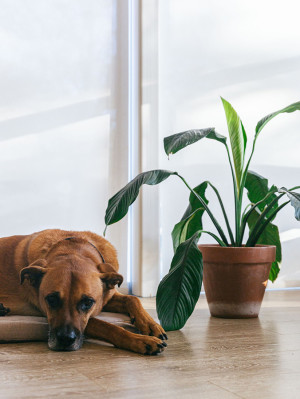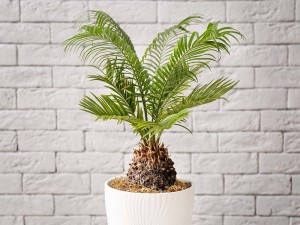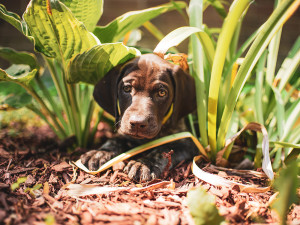Are Snake Plants Toxic to My Dog?
Just get a new dog? Might be time to find a new home for your snake plant.

share article

Your pet wants you to read our newsletter. (Then give them a treat.)
OK, so you’ve just brought home a new dog or puppy. Now, comes the task of analyzing everything in your home to make sure it’s safe for your new family member. Maybe at the top of that list? Your plants. Making your house into an indoor jungle is definitely enticing — and a cozy idea — but just make sure your dog can inhabit that jungle as well.
So, back to the list of unsafe plants. Snake plants are definitely trendy these days, and you hear they’re pretty easy to care for. But are they safe for your dog? Short answer: No. Here’s why.
Why are snake plants dangerous to dogs?
Snake plants contain toxins called saponins, waxy compounds that can cause vomiting and diarrhea in dogs. Saponins help protect plants from insects, bacteria, and fungi. Their bitter, unpleasant flavor often keeps curious animals from sampling too much of a plant. When ingested, saponins interact unfavorably with cholesterol in the body.
One of cholesterol’s functions is to maintain the stability of cell membranes. When ingested, saponins bind with cholesterol in the intestines and make intestinal cells weak and leaky. This can cause improper water balance that leads to diarrhea. If ingested in large amounts, they can lead to severe inflammation of the intestines.
What should I do if my dog has eaten a snake plant?
If your dog has eaten any amount of a snake plant, keep a watchful eye for the development of gastrointestinal upset. Dogs who only ingest a small amount of toxic plant material may only experience a minor bout of diarrhea and be fine otherwise. Contact your veterinarian if your dog experiences profuse vomiting or diarrhea, produces bloody vomit or diarrhea, or if they seem weak or lethargic. If your dog ate a whole plant, it’s best to be proactive and consult with a veterinarian, even if symptoms haven’t developed yet.
Diagnosing Snake Plant Poisoning in Dogs
Pet parents play a huge role in the diagnosis of snake plant toxicity. After all, who else would know what’s in your house and what your dog has access to? If you find your snake plant knocked over, nibbled on, or completely destroyed, you should report those findings to your veterinarian. Lots (and I mean lots) of things can cause vomiting and diarrhea in dogs, so giving your vet a heads up that your dog likely munched on a snake plant can eliminate a lot of guesswork.
Symptoms of Snake Plant Poisoning in Dogs
Snake plants are considered to be mild-to-moderately toxic to dogs. Some dogs may only experience mild nausea while others can develop severe gastrointestinal upset. Symptoms of ingestion include:
Nausea
Diarrhea
Vomiting (sometimes with blood)
Drooling
Treatment For Snake Plant Ingestion in Dogs
Dogs who are sick after ingesting a snake plant are treated with symptomatic supportive care. This may include anti-nausea medication, anti-diarrheal medication, fluid therapy, and a bland diet. Your vet may recommend bloodwork to evaluate a dog’s hydration status. Many dogs are able to recover at home, but some may require hospitalization.
How to Prevent Snake Plant Poisoning
The best way to prevent snake plant poisoning is to eliminate access. Remove snake plants from the home and replace them with more pet-safe options. If you and your snake plant have already formed an unbreakable bond, make sure that it’s kept well beyond your dog's reach.
Are all parts of snake plants poisonous to dogs?
All parts of a snake plant are toxic to dogs. Saponins are most concentrated in the leaves, which are essentially the whole plant.
How do I stop my dog from eating snake plants?
The easiest way to stop your dog from eating snake plants is to keep your dog far away from the plant. Keep the plant high up and out of reach or in a room where your dog is not allowed. It’s also good practice to teach your dog basic “drop” commands in case they gain unexpected access and are caught with a leaf in their mouth.
The bottom line: Are snake plants poisonous to my dog?
Snake plants are poisonous to dogs and should be kept away from them. Whenever considering a new plant for your home, do a little research to ensure you choose a dog-safe option. A good place to start is ASPCA Animal Poison Control’s plant database. If you’re gifted a plant and unsure of its species, play it safe and keep it away from your dog.
Other Plants That Are Safe For Dogs
Kentia palm (Howea belmoreana): Also called a curly palm or sentry palm, this tall palm can tolerate novice plant parents and a couple curious nibbles from a dog.
Prayer Plant (Maranta leuconeura)opens in a new tab: The striped leaves of this pet-safe plant fold up like praying hands when the sun goes down, which is kinda cool.
Baby rubber plant (Peperomia obtusifolia): This dog-friendly plant is also known to be low maintenance and is a great option for people whose energy tends to go to their dogs and not towards fussing over their plants.
Other Plants That Are Dangerous For Dogs
Sago palm (opens in a new tab: This ornamental plant is horrendously toxic to dogs. Dogs who eat any part of a sago palm can develop vomiting, bloody diarrhea, and liver damage.
ZZ Plant (Zamioculcas zamiifolia): This hardy plant contains calcium oxalates, which can cause vomiting and diarrhea in dogs who eat the leaves. Calcium oxalate can also cause irritation to the gums and tongue, which may prevent a dog from swallowing more of the plant but will still leave them in pain.
Aloe veraopens in a new tab: Although aloe vera gel is considered non-toxic, the leaves that coat and protect the gooey center are toxic to dogs. Dogs who eat aloe vera plants can develop vomiting, diarrhea, and lethargy.
FAQs (People Also Ask):
What happens if a dog eats a snake plant?
Some dogs who eat snake plants may only experience mild nausea, while others can develop severe gastrointestinal upset.
How much of a snake plant is toxic to a dog?
All parts of a snake plant are considered toxic, and dogs should not eat any amount of snake plant.
Are snake plants poisonous to dogs?
Snake plants contain saponins, which can cause vomiting and diarrhea in dogs.
Can dogs eat snake plants safely?
Snake plants are considered to be mild to moderately toxic to dogs. Dogs cannot eat snake plants safely.
Are snake plants poisonous to dogs if they smell them?
Dogs should not experience any ill effects if they just sniff a snake plant, but they should be kept away from the plant to prevent accidental ingestion.
References

Dr. Alycia Washington, DVM, MS
Alycia Washington, DVM, is a small animal emergency veterinarian based in North Carolina. She works as a relief veterinarianopens in a new tab and provides services to numerous emergency and specialty hospitals. Dr. Washington is also a children’s book author and freelance writer with a focus on veterinary medicine. She has a special fondness for turtles, honey bees, and penguins — none of which she treats. In her free time, Dr. Washington enjoys travel, good food, and good enough coffee.
Related articles
![Plant Kween standing in a greenhouse space wearing brightly colored pants and a beige corset top smiling in a carefree way]() opens in a new tab
opens in a new tabThe Plant Kween Has Spoken!
We’ve got the fabulous gardener’s take on pet-friendly plants.
![woman with new puppy]() opens in a new tab
opens in a new tab9 Unexpected To-Dos for New Pet Parents
Sound advice from seasoned dog and cat parents who have been there.
![Young Woman Working From Home with Her Dog]() opens in a new tab
opens in a new tabThe 10 Best Non-Toxic House Plants for Dogs
Brb, running out to buy air plants and succulents.
- opens in a new tab
“Can My Dog Be Trained Not to Dig?”
Stop your dog from digging up your favorite plants with expert advice from animal behaviorist Karen London, PhD.
![Beagle dog fetching a green rope in a dog-proofed living room.]() opens in a new tab
opens in a new tabHow to Dog-Proof Your Home
Our room-to-room guide to get your house in dog-safe shape.
![goldendoodle puppy playing in grass in yard]() opens in a new tab
opens in a new tabThe Dirt on Dog-Proofing Your Yard
10 steps to a safe outdoor space. Landscaper not required.









